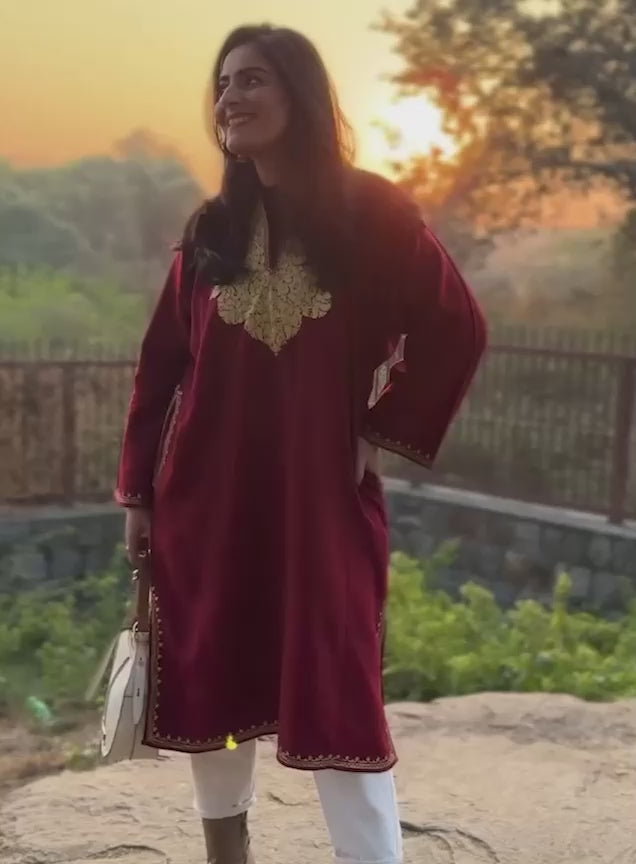Find Your Perfect Phiran
A phiran (AKA - Pheran) is Kashmir’s go-to winter layer, roomy at the shoulders, open at the sides and long enough to graze the knee. That shape does two useful things. First, it traps a cushion of warm air so you feel sheltered even when the wind picks up. Second, it leaves space for whatever you already have on, from a thermal tee to straight-leg denim, so layering is simple rather than bulky. Tradition pairs the phiran with a clay fire pot called a kangri tucked at the waist; today’s phiran moves effortlessly between home, commute, and outdoor gatherings.
Choosing the Fabric
-
Wool blend: Merino rich yarns in Namastay phirans stay soft against skin yet hold heat from morning errands in late November to evening gatherings in February.
-
Cotton twill: Breathable cotton suits shoulder seasons or travel days when cabin air turns chilly. Add a thermal inner layer and it handles sudden dips in temperature.
Fit and Sizing
Patterns run from XS to 3XL. A slightly wider shoulder lets the cloth fall straight rather than cling, and side vents keep your stride natural even in boots. If you want more definition, wrap a slim belt at the waist; the embroidery stays flat and the outline sharpens in seconds.
Colour Cues
-
Neutrals such as black, ivory and charcoal pair with outerwear you already own.
-
Jewel tones like emerald, sapphire and wine hold depth in photographs and echo traditional Kashmiri shawls.
-
Soft tints including dusty rose, mustard and sky blue lighten the look for early spring streets.
Raised aari vines finish every shade. Tiny variations in each motif confirm a skilled hand, never a programmed hoop.
When and Where to Wear
-
Daily errands: cotton phiran, trainers, cross body bag.
-
Office route: wool phiran, ankle boots, structured tote.
-
Winter wedding: deep crimson wool, statement earrings, lined leggings for outdoor photos.
-
Travel layer: cotton phiran over a long sleeve tee, folds neatly into cabin luggage.
Care in Four Simple Steps
-
Turn the garment inside out.
-
Hand wash wool in cold water; choose the gentle cycle for cotton.
-
Lay flat to dry, smoothing the embroidery with your palms.
-
Steam lightly to refresh before the next outing.
The Namastay Promise
-
Hand work only, never machine loops.
-
Orders leave our studio in two days with free cash on delivery across India and easy returns.
-
Every purchase funds fair wages, safe workshops and new apprenticeships in Kashmir so the craft thrives for the next generation.
Shop and gain a warm, roomy layer that moves through your day with the quiet beauty of Kashmiri craftsmanship.
FAQs about Pheran
Is the phiran lined or left unlined?
Each phiran is unlined so it drapes easily, but the dense Merino rich wool blend traps air for warmth and the aari embroidery anchors the layers together so the fabric never feels flimsy.
How long should a phiran be on the body?
The standard length falls just above the knee on an average height of one hundred sixty five centimetres. This keeps the core warm while allowing natural movement. If you are taller or prefer extra coverage, choose the next size up; the shoulder and chest still fit comfortably thanks to the relaxed cut.
Does the phiran have pockets?
Yes. Discreet side pockets sit inside the seam on most styles so you can warm your hands or keep a phone close without adding bulk to the outline.
Will the wool blend feel itchy on sensitive skin?
The yarn mix is high in fine Merino fibres that are naturally soft and low in micron count, so the surface feels smooth even when worn over a short sleeve layer. Cotton twill versions are even gentler if you prefer plant based fabrics.
Can I dress a phiran up for a formal gathering?
Absolutely. Choose a jewel tone like emerald or wine, add slim dark trousers, heeled ankle boots, and statement earrings. The raised aari vines catch light in photographs and the straight falling silhouette reads as elegant rather than casual.















































